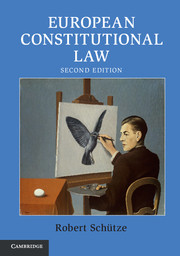Book contents
- Frontmatter
- Dedication
- Summary Contents
- Contents
- List of Illustrations
- List of Tables
- List of Cases
- List of Secondary Law
- Table of Equivalents
- List of Abbreviations
- Acknowledgements
- Introduction: European Constitutional Law
- Part I Constitutional Foundations
- 1 Constitutional History: From Paris to Lisbon
- 2 Constitutional Nature: A Federation of States
- 3 European Law I: Nature – Direct Effect
- 4 European Law II: Nature – Supremacy/Pre-emption
- 5 Governmental Structure: Union Institutions I
- 6 Governmental Structure: Union Institutions II
- Part II Governmental Powers
- Appendices
- Index
- References
6 - Governmental Structure: Union Institutions II
from Part I - Constitutional Foundations
- Frontmatter
- Dedication
- Summary Contents
- Contents
- List of Illustrations
- List of Tables
- List of Cases
- List of Secondary Law
- Table of Equivalents
- List of Abbreviations
- Acknowledgements
- Introduction: European Constitutional Law
- Part I Constitutional Foundations
- 1 Constitutional History: From Paris to Lisbon
- 2 Constitutional Nature: A Federation of States
- 3 European Law I: Nature – Direct Effect
- 4 European Law II: Nature – Supremacy/Pre-emption
- 5 Governmental Structure: Union Institutions I
- 6 Governmental Structure: Union Institutions II
- Part II Governmental Powers
- Appendices
- Index
- References
Summary
The Commission
The technocratic character of the early European Union expressed itself in the name of a fourth institution: the Commission. The Commission constituted the centre of the European Coal and Steel Community, where it was ‘to ensure that the objectives set out in [that] Treaty [were] attained’. In the European Union, the role of the Commission is, however, ‘marginalised’ by the Parliament and the Council. With these two institutions constituting the Union legislature, the Commission is now firmly located in the executive branch. In guiding the Union, it – partly – acts like the Union's government (in the strict sense of the term). This section analyses the composition and structure of the Commission, before looking at its internal decision-making procedures. The functions and powers of the Commission will be discussed next, before an excursus briefly presents European Agencies as auxiliary organs of the Commission.
Composition and Structure
The Commission consists of one national of each Member State. Its members are chosen ‘on the ground of their general competence and European commitment from persons whose independence is beyond doubt’. The Commission's term of office is five years. During this term, it must be ‘completely independent’. Its members ‘shall neither seek nor take instructions from any Government or other institution, body, office or entity’. The Member States are under a duty to respect this independence. Breach of the duty of independence may lead to a Commissioner being ‘compulsorily retired’.
How is the Commission selected? Originally, the Commission was ‘appointed’. The appointment procedure has subsequently given way to an election procedure. This election procedure has two stages. In a first stage, the President of the Commission will be elected. The President will have been nominated by the European Council ‘[t]aking into account the elections to the European Parliament’, that is: in accordance with the latter's political majority. The nominated candidate must then be ‘elected’ by the European Parliament. If not confirmed by Parliament, a new candidate needs to be found by the European Council.
After the election of the Commission President begins the second stage of the selection process. By common accord with the President, the Council will adopt a list of candidate Commissioners on the basis of suggestions made by the Member States.
- Type
- Chapter
- Information
- European Constitutional Law , pp. 185 - 220Publisher: Cambridge University PressPrint publication year: 2015



